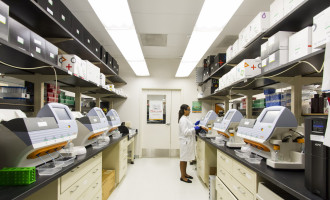
This comprehensive review is led by Ruowa Xu, Yunlong Gao (Fudan University), Hailong Zhang (Henan University), and Zichao Luo (Fudan University), bringing together expertise in ophthalmology, nanomedicine, and oncology.
The team’s analysis stems from a critical need in precision oncology: overcoming tumour heterogeneity and therapeutic resistance through multifunctional platforms that unify therapy, diagnosis, and immune modulation.
Vitamins, with their intrinsic biocompatibility, metabolic activity, and receptor-targeting properties, have emerged as ideal building blocks for such nanoplatforms—especially in addressing the limitations of conventional nanocarriers (e.g., "polyethylene glycol dilemma," poor bioactivity, and off-target toxicity).
Immunomodulation: Reprogramming the Tumour Immune Microenvironment
The review emphasises that vitamin-derived nanoplatforms act as potent immunomodulators by targeting key components of the immunosuppressive TME.
For fat-soluble vitamins:
Vitamin A (Retinol): Nanoparticles (e.g., retinoic acid-loaded PLGA) block M2 macrophage polarisation, enhance dendritic cell (DC) maturation, and balance Th1/Th2 T-cell differentiation.
In preclinical colorectal cancer models, these nanoplatforms synergized with anti-PD-L1 antibodies to reduce tumour volume by 1.14-fold vs.
free drugs and inhibit epithelial–mesenchymal transition (EMT).
Vitamin D (Calcitriol): Biomimetic nanoplatforms (e.g., vitamin D3-functionalized neutrophil membrane-coated MnO₂ nanoparticles) activate the cGAS-STING pathway, reverse TME immunosuppression, and penetrate the blood–brain barrier.
In glioblastoma models, this approach extended median survival by ~73% vs. conventional chemotherapy.
Vitamin E (Tocopherol): Lipid-based nanocarriers (e.g., α-tocopheryl succinate-loaded liposomes) suppress NF-κB/STAT3 signalling, reduce PD-L1 expression by ~72%, and enhance antigen cross-presentation.
One mRNA-delivering vitamin E scaffold (ssPalmE-KALA) achieved ~95% tumour growth inhibition in prophylactic models.
Vitamin K: Metal-organic framework (MOF)-based nanoplatforms (e.g., VK3@Co–Fc) induce immunogenic cell death (ICD) via redox cycling, increasing CD8⁺ T-cell infiltration by 3.7-fold and reducing pulmonary metastases by 83.5% in breast cancer models.
For water-soluble vitamins:
Vitamin B Complex: Folate (B9)-targeted nanogels (e.g., VB7/siRNA) achieve 2–3-fold higher siRNA delivery efficiency in cancer cells vs.
normal cells, suppressing VEGF expression by 85% to remodel the TME.
Vitamin B3 (niacin) activates GPR109A to reduce immunosuppressive myeloid cells and boost CD8⁺ T-cell responses.
Vitamin C (Ascorbic Acid): Gold nanoparticles conjugated with vitamin C target cancer stem cells, while liposomal co-delivery with indocyanine green polarises M2 macrophages to M1 phenotypes.
In bladder cancer models, this combination suppressed tumour growth by ~90% when paired with anti-PD-L1.
Precision Drug Delivery: Overcoming Pharmacological Barriers
Vitamin-integrated nanosystems address critical limitations of conventional anticancer agents (poor solubility, low bioavailability, systemic toxicity) through two synergistic strategies:
Nanoencapsulation of Vitamins as Payloads: Lipid (e.g., nanostructured lipid carriers for vitamin D) and polymeric (e.g., PLGA for vitamin A) nanocarriers enhance stability and control release.
For example, liposomal all-trans retinoic acid (ATRA) reduced hepatic metabolism, improved bioavailability, and lowered toxicity in a Phase I trial for renal cell carcinoma.
Vitamins as Structural/Targeting Components: Folate (FRα targeting), vitamin B12 (CD320 targeting), and vitamin E derivatives (e.g., TPGS) enable receptor-mediated endocytosis.
TPGS, an FDA-approved surfactant, reverses multidrug resistance (MDR) by inhibiting P-glycoprotein, increasing paclitaxel uptake by >10-fold in resistant lung cancer cells.
Synergistic co-delivery systems further amplify efficacy.
For instance, vitamin B2-ferric chloride nanocomplexes (VFNCs) act as sonosensitizers to generate reactive oxygen species (ROS), achieving 65.6% tumour suppression in triple-negative breast cancer (TNBC) when combined with ultrasound and metformin.
Diagnostic Integration: Toward "See-and-Treat" Theranostics
Vitamin-based nanoplatforms integrate imaging and therapy by leveraging receptor targeting and chemical modifiability:
Imaging Probes: Folate-PEGylated near-infrared (NIR) probes (e.g., fPI-01) achieve a tumour-to-normal tissue ratio of 20:1 for early FR⁺ tumour detection.
Vitamin E-core iodinated nano-emulsions enable prolonged (>4 months) high-contrast micro-CT imaging of the liver.
Theranostic Hybrids: TPGS-modified upconversion nanoparticles co-deliver doxorubicin and imaging agents, enabling real-time fluorescence resonance energy transfer (FRET) monitoring of drug release.
In MDR breast cancer, this system reduced IC₅₀ by 7.7-fold vs. free drugs.
Challenges and Future Directions
Despite preclinical success, the team identifies key barriers to translation:
Biocompatibility: Long-term organ accumulation (e.g., gold nanoparticles in the liver) and immune dysregulation require rigorous safety profiling.
Scalability: Reproducible manufacturing of vitamin-based nanoplatforms (e.g., microfluidic encapsulation) is critical for batch-to-batch consistency.
Clinical Heterogeneity: Variable vitamin receptor expression (e.g., FRα) across tumours demands patient stratification or combinatorial targeting.
The authors advocate for future research focused on AI-driven nanocarrier design, multi-omics profiling for patient selection, and integration with emerging modalities (e.g., CAR-T, oncolytic viruses).
"By converging vitamin biology with nano-immunoengineering, these platforms hold transformative potential to bridge nutrient science and precision oncology," says Zichao Luo.
See the article
Source: Sichuan International Medical Exchange and Promotion Association